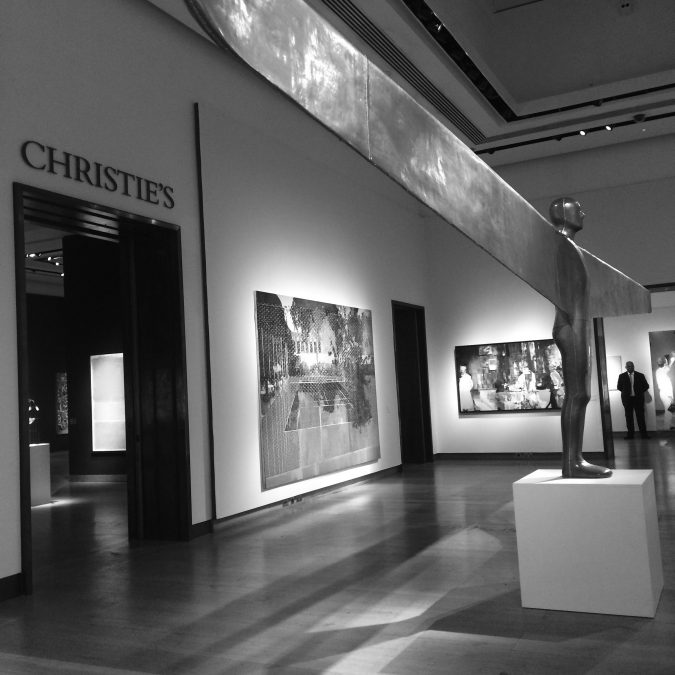Antony Gormley’s “A Case for An Angel I” (1989) on display at Christie’s showrooms in London before a Post-War and Contemporary Sale.
Key Principles to Keep in Mind When Building a Contemporary Art Collection
What is the difference between buying works of art, and building an art collection? The difference between these two seemingly identical actions is subtle but significant, and distinguishes between trend-followers and serious collectors. American art dealer and film producer Barbara Gladstone is quoted as saying, “Art is an intellectual pursuit. It is not a hand-bag, it is not a chair, it is something else. So it is necessary to think, to ask questions and to understand.” Art collecting is more than glorified shopping; rather, it is a challenging and rigorous intellectual endeavour that requires passion and dedication. While every successful collector has his or her own method, there seem to be certain tried and tested strategies and attitudes that successful collectors have adopted.
Firstly, art should be used to constantly challenge oneself. While it is important to know one’s own personal taste and preference, keeping an open mind to new artists and new ideas is also essential. Some collectors adhere to strict guidelines when building their collection, only buying works from specific artists or time periods. In this case, collectors may be sacrificing dynamism for consistency.
Whilst collecting a movement or an artist in depth demonstrates commitment and expertise, collectors that wear blinkers run the risk of missing the new and challenging art resting in their periphery. A collector that consistently buys art that he or she likes and understands misses opportunities to have negative emotional reactions towards art. Art that disturbs and disgusts holds a certain power over us, places us in a trance of repulsion, and in refusing to engage with our own discomfort, we deny ourselves the opportunity to be truly challenged.
In “Owning Art”, a book by Judith Greer and Louisa Buck, art advisor and Sotheby’s chairman Allan Schwartzman explains that individuals tend to initially respond to what they are familiar with, but, “If someone is to evolve as an art collector, they have to get tougher. What they find over time is that the things that they immediately responded to are maybe not the ones that stick with them. Maybe there isn’t so much depth there, and the things that they end up being challenged by are the very ones that disturbed them, or that they discounted at the beginning. So art collecting is an evolving process. It is an education.” Buying art is easy, while collecting is difficult because it requires self-education and invites self-transformation by way of introspection.
Secondly, Contemporary art is unique because it is constantly being created and produced. A collector could research emerging artists for days and barely scratch the surface of Contemporary artists’ immense production. Unlike collecting the works of the Impressionists or Old Masters, Contemporary art allows collectors to have a dialogue and relationship with the artist. These relationships add a personal and historical dimension to a collection. Collecting an artist’s work during his or her career is the ultimate vote of confidence – this type of confidence can only be positive, both institutionally and financially. After all, institutional success for an artist is always in a collector’s best interest.
The best way to make money from art is to invest in the artist, supporting his or her work, giving commissions, and financing further creation and experimentation. Gallerist Sadie Coles explains, “The type of collector who buys deeply and specifically concentrates on the work of an artist, building up a collection of breadth that can be displayed by or loaned to institutions, has an important impact on the artist’s career.” Investing in artists leads to collectors becoming influencers and tastemakers.
Finally, Contemporary art allows collectors to experiment with a wide range of mediums, from more traditional art forms such as painting, to newer and more experimental mediums such as video or performance art. Newer mediums, or those with multiple editions like prints or photography, are often at much lower price points, making it is easier for a collector to experiment without incurring a significant financial loss. Collecting an artist’s work across a variety of mediums adds both depth and breadth to one’s collection, while giving the collector a deeper understanding of an artist’s key concepts and practices.
Overall, it is important for collectors to believe in the vision for their collection so confidently that they are not afraid to question their own feelings, thoughts, and opinions towards it. Supporting artists and experimenting with medium are two important ways that collectors can simultaneously support and challenge their own artistic vision.
To read more about major contemporary art auctions, read ArtTactic’s latest report on New York’s Post-War and Contemporary Day Sale, and Evening Sale, in November 2017.
All quotes in this article originate from interviews conducted by Louisa Buck and Judith Greer, which appear in their book “Owning Art: The Contemporary Art Collector’s Handbook”.

